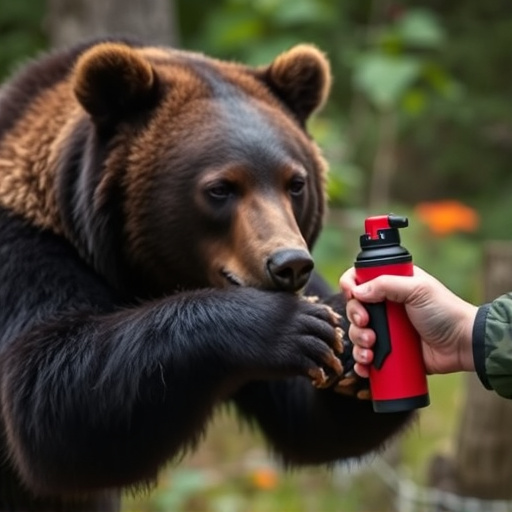Hiking in bear country requires understanding bear behavior and using bear repellent spray effectively. Bear spray creates an irritant barrier, causing bears to retreat upon immediate contact with sensitive areas. Proper usage involves aiming at the bear's face and body while backing away slowly. Accidental discharge prevention is critical; inspect nozzles for damage, store spray securely, keep out of children's reach, and use proper deployment techniques. Choosing the right bear repellent depends on bear species, desired range, frequency of application, weather conditions, and safety features like easy-to-use triggers.
“Embarking on a hike in bear country? Don’t underestimate the importance of bear repellent spray—a vital tool for your safety. This comprehensive guide explores why this necessity goes beyond deterring bears, delving into the mechanics of bear spray and offering essential tips for accidental discharge prevention. From understanding bear behavior to choosing the right spray, arm yourself with knowledge. Stay safe while exploring nature’s tapestry, where a quick squirt could be the difference between a close encounter and a peaceful hike.”
- Understanding Bear Behavior and Why Repellent Spray is Crucial
- The Mechanics of Bear Spray: How It Works and What to Expect
- Accidental Discharge Prevention Tips for Hikers
- Choosing the Right Bear Repellent Spray for Your Needs
Understanding Bear Behavior and Why Repellent Spray is Crucial
Understanding bear behavior is key to ensuring a safe hiking experience in areas where bears are present. These powerful animals have an excellent sense of smell and can detect potential threats from miles away. They primarily use their strong senses to avoid confrontations, but when they feel threatened or surprised, bears may react aggressively, especially if they are protecting their cubs or food sources. A sudden movement, loud noise, or even the scent of food on your person could trigger a bear’s protective response.
Bear repellent spray is crucial for hikers as it provides an additional layer of protection against unexpected encounters. Unlike other animal deterrents, bear spray is designed to be effective at close range, which is often when bears become aggressive. Proper usage techniques, such as aiming for the bear’s face and eyes, can greatly reduce the risk of an accidental discharge, ensuring hikers have a safe escape should a bear approach. Preventing accidental discharges is essential, as it keeps both hikers and bears safe during their shared wilderness experiences.
The Mechanics of Bear Spray: How It Works and What to Expect
Bear spray, also known as bear repellent spray, is a crucial tool for hikers and outdoor enthusiasts navigating areas inhabited by bears. Its effectiveness lies in its unique formulation that creates a barrier between the user and the bear. When sprayed, it irritates the bear’s eyes, nose, and respiratory system, causing them to retreat or avoid the area. This instant reaction can be a lifesaver, especially during unexpected encounters.
Proper usage involves aiming for the bear’s face and body, creating a cloud of spray as you back away slowly. It’s essential to practice this technique before hiking in bear country to understand the range and proper application. Additionally, regular maintenance and checking expiration dates are vital to ensure the spray remains effective. Accidental discharge prevention techniques should also be learned, such as storing the spray securely and keeping it out of reach of children or pets, to avoid any unwanted incidents during your hike.
Accidental Discharge Prevention Tips for Hikers
To prevent accidental bear spray discharge while hiking, follow these essential tips. First, always inspect the nozzle for any debris or damage before each use; even a tiny blockage can cause the can to discharge unexpectedly when activated. Second, keep the spray can out of reach of children and pets; ensure everyone understands its purpose and handles it carefully. Third, store bear repellent spray in a secure, closed container to prevent accidental activation, especially during transport.
When deploying the spray, remember to point it away from yourself and towards the approaching bear. Keep your back against a solid object for added protection. Practice proper technique: hold the can upright, activate the trigger with a firm motion, and follow the manufacturer’s instructions on range and angle of application. Regularly review safety guidelines and carry a backup plan, like noise makers or bear deterrents, to enhance your overall safety during outdoor adventures.
Choosing the Right Bear Repellent Spray for Your Needs
When selecting a bear repellent spray, understanding your specific needs is paramount. Different situations require distinct features. For instance, if you’re primarily hiking in grizzly bear country, opt for a spray with a longer range and stronger concentration of capsaicin or other active ingredients. These can deter bears from a distance. On the other hand, for more densely populated areas with black bears, consider a spray with a shorter range but higher frequency of application, as black bears are often less deterred by traditional repellents.
Accidental bear spray discharge prevention is another crucial aspect to look into. Features like easy-to-use triggers and safety mechanisms can minimize the risk of accidental activation, ensuring your peace of mind during hikes. Additionally, checking the weather conditions before use is essential; wind and humidity can affect the spray’s effectiveness, so choose a repellent designed for optimal performance in your expected environment.
When hiking in bear country, carrying bear repellent spray is an absolute necessity. Understanding how these sprays work and implementing preventive measures against accidental discharge can significantly enhance your safety during outdoor adventures. By choosing the right product tailored to your specific needs, you’ll be well-prepared to face potential bear encounters with confidence and peace of mind. Remember, knowledge and preparedness are key to navigating these wild environments safely.
